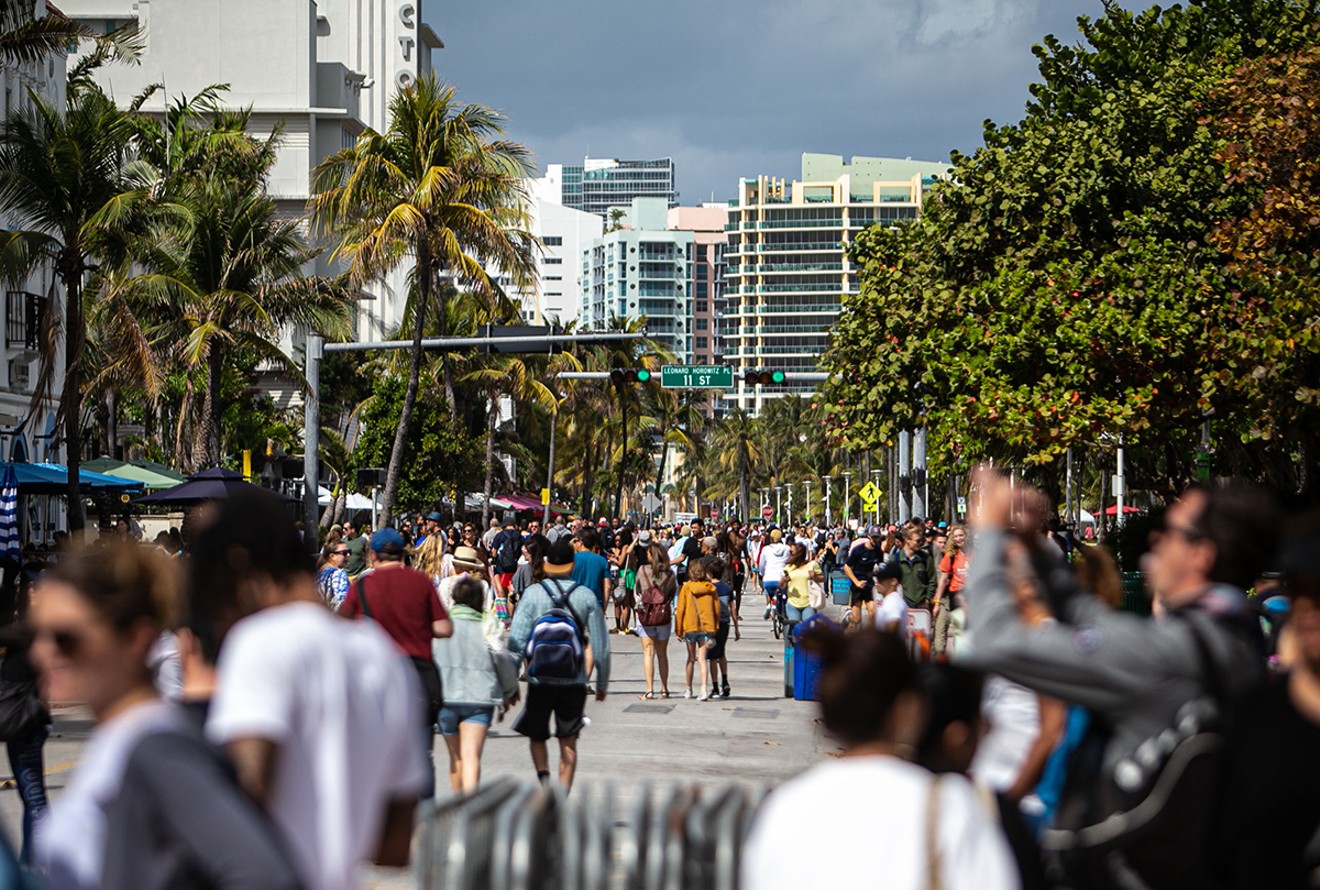South Beach's Ocean Drive is a world-renowned destination. Some might call it a palm tree-lined art deco state of mind. It is, of course, also a street. One that, as currently constructed, has cars, trucks, and double-decker tour buses driving up and down.
Sometimes, though, Ocean Drive is closed off to traffic.
Over Art Deco Weekend, it's adorned by classic cars — all of them parked. For the Fourth of July and New Year's Eve, it is traditionally blocked off, the better for crowds to gather for the fireworks. When South Florida hosted the Super Bowl in February, the ten blocks of Ocean Drive from Fifth to 15th streets were closed off.
Every time, the response after experiencing a car-free Ocean Drive: Why can't this famed street always be like this?
This year has been an incredibly difficult time for many, but if there is one positive thing that has come out of 2020, it's that Miami Beach's iconic street might say farewell to cars.
In the early days of the pandemic, when businesses were closed and beach access was prohibited, cars were allowed on Ocean Drive. But so few people were coming to South Beach, you'd be forgiven for thinking Ocean Drive was closed off to vehicular traffic.
When businesses reopened in May, the City of Miami Beach officially closed the strip to vehicle traffic in order to create additional space for sidewalk cafés and encourage social distancing.
But this month brought a bizarre compromise that pleased nobody. The City of Miami Beach installed barricades allowing for traffic to take up one lane going northbound. This gave pedestrians and restaurants less space to social-distance while at the same time increased the chances for an accident by placing vehicular traffic and pedestrians in close proximity.
Last week, Miami Beach City Manager Jimmy Morales proposed reclosing Ocean Drive to cars until further notice, and on Friday, the city commission passed a resolution to that effect.
Famed South Florida architect Elizabeth Plater-Zyberk says Ocean Drive is an obvious candidate for pedestrian-only status.
"You're not driving on Ocean Drive to go anywhere," says the famed New Urbanism pioneer, who cofounded Arquitectonica in the 1970s before moving on to DPZ with her husband, Andés Duany. "It's a cruising street."
Alleyways can handle servicing, Plater-Zyberk says, adding that the only drawback to banning vehicles would be the lack of access to the hotels on the strip.
"It's not a traffic issue. Cars would just be pushed off to Collins or Washington," she says. "Only pickups and dropoffs to hotels need that frontage. In Rome or Florence, there are a lot of places frequented by tourists where only taxis are allowed to drive for just that reason. Then there are other places in Europe where cars are completely not allowed, and tourists just have to roll their suitcase to their hotel."
She thinks current circumstances make it an ideal time to experiment with Ocean Drive.
"This is an opportunity to test it out and see what restaurants think," she says. "You could try it out for the rest of the summer or even into the winter when the tourist load picks up. While you study it, whatever controversy is generated can be resolved."
Famous beaches around the world have created a paved buffer between the hustle and bustle of city life. California's Venice Beach has its boardwalk, as do Atlantic City and Santa Cruz. You just need to drive an hour north to Hollywood Beach to see how pleasant a beach-adjacent space free of cars can be.
It might finally be time for Ocean Drive to take its place in that beachfront promenade.
[
{
"name": "Air - MediumRectangle - Inline Content - Mobile Display Size",
"component": "19274298",
"insertPoint": "2",
"requiredCountToDisplay": "2"
},{
"name": "Editor Picks",
"component": "17482312",
"insertPoint": "4",
"requiredCountToDisplay": "1"
},{
"name": "Inline Links",
"component": "18711090",
"insertPoint": "8th",
"startingPoint": 8,
"requiredCountToDisplay": "7",
"maxInsertions": 25
},{
"name": "Air - MediumRectangle - Combo - Inline Content",
"component": "17482310",
"insertPoint": "8th",
"startingPoint": 8,
"requiredCountToDisplay": "7",
"maxInsertions": 25
},{
"name": "Inline Links",
"component": "18711090",
"insertPoint": "8th",
"startingPoint": 12,
"requiredCountToDisplay": "11",
"maxInsertions": 25
},{
"name": "Air - Leaderboard Tower - Combo - Inline Content",
"component": "17482313",
"insertPoint": "8th",
"startingPoint": 12,
"requiredCountToDisplay": "11",
"maxInsertions": 25
}
]












